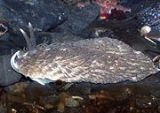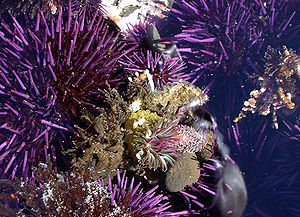
Aeolidia papillosa
Encyclopedia
Aeolidia papillosa is a species
of sea slug
, an aeolid nudibranch
, a marine
gastropod mollusk in the family Aeolidiidae
. A. papillosa has many common names including the shaggy mouse nudibranch or the shag rug nudibranch, in part due to its shape and its numerous flattened cerata that make it look rather like a bedraggled mouse
or like a shag rug
.

, the Atlantic coast of North America
, and the Pacific Coast of North America
. It also appears to occur on the west and east coast of South America
.
s to the mid dorsum
. The cerata vary in color from grey to white and sometimes pink, orange, or green hues, depending on the species of anemone it has been feeding on. Though sometimes smaller, this species can grow to a length of 10 cm(4 in) in the Pacific Ocean and up to 12 cm(5 in) in the Atlantic Ocean. The maximum recorded length is 100 mm.
 While sea anemone
While sea anemone
s are a component of most nudibranch’s diet, Aeolidia papillosa feed almost entirely on various species of anemones. However, due to limited mobility of nudibranchs and often highly concentrated distribution of prey, individual nudibranchs may concentrate on an individual species of prey during their lifetime.
while contributing greatly to their host’s growth. Research has shown that these symbionts continue to perform high levels of photosynthesis and remain in Aeolidia papillosa’s cerata for as much as eleven days, translocating a significant amount of fixed carbon to the nudibranch’s bodily tissues.
which are then stored as newly formed kleptocnidae in muscularized chambers, called cnidosacs, which are located at the tips of the cerata
. These cnidosacs are capable of ejecting the kleptocnidae when under threat or attack.
Species
In biology, a species is one of the basic units of biological classification and a taxonomic rank. A species is often defined as a group of organisms capable of interbreeding and producing fertile offspring. While in many cases this definition is adequate, more precise or differing measures are...
of sea slug
Slug
Slug is a common name that is normally applied to any gastropod mollusc that lacks a shell, has a very reduced shell, or has a small internal shell...
, an aeolid nudibranch
Nudibranch
A nudibranch is a member of what is now a taxonomic clade, and what was previously a suborder, of soft-bodied, marine gastropod mollusks which shed their shell after their larval stage. They are noted for their often extraordinary colors and striking forms...
, a marine
Marine (ocean)
Marine is an umbrella term. As an adjective it is usually applicable to things relating to the sea or ocean, such as marine biology, marine ecology and marine geology...
gastropod mollusk in the family Aeolidiidae
Aeolidiidae
Aeolidiidae, the aeolid nudibranchs, are a family of Nudibranchs. Many feed on hydroids and thus have highly serrated radular teeth.- Genera :Genera and species within the Aeolidiidae include:* Aeolidia Cuvier, 1797 - type genus...
. A. papillosa has many common names including the shaggy mouse nudibranch or the shag rug nudibranch, in part due to its shape and its numerous flattened cerata that make it look rather like a bedraggled mouse
Mouse
A mouse is a small mammal belonging to the order of rodents. The best known mouse species is the common house mouse . It is also a popular pet. In some places, certain kinds of field mice are also common. This rodent is eaten by large birds such as hawks and eagles...
or like a shag rug
Shag (fabric)
A shag is a rug or carpet that has a deep pile, giving it a shaggy appearance. Shag carpeting is sometimes evoked as an example of the esthetic from the culture of the 1970s in the United States....
.

Distribution
This nudibranch species lives on the Atlantic coast of The British Isles and Northern EuropeNorthern Europe
Northern Europe is the northern part or region of Europe. Northern Europe typically refers to the seven countries in the northern part of the European subcontinent which includes Denmark, Estonia, Latvia, Lithuania, Norway, Finland and Sweden...
, the Atlantic coast of North America
North America
North America is a continent wholly within the Northern Hemisphere and almost wholly within the Western Hemisphere. It is also considered a northern subcontinent of the Americas...
, and the Pacific Coast of North America
North America
North America is a continent wholly within the Northern Hemisphere and almost wholly within the Western Hemisphere. It is also considered a northern subcontinent of the Americas...
. It also appears to occur on the west and east coast of South America
South America
South America is a continent situated in the Western Hemisphere, mostly in the Southern Hemisphere, with a relatively small portion in the Northern Hemisphere. The continent is also considered a subcontinent of the Americas. It is bordered on the west by the Pacific Ocean and on the north and east...
.
Description
Aeolidia papillosa can be easily identified by its large number of flattened cerata on its body except for a triangular area that extends from the rhinophoreRhinophore
A rhinophore is one of a pair of club-shaped structures which are the most prominent part of the external head anatomy of a group of sea slugs, marine gastropod opisthobranch mollusks in the order Nudibranchia, the nudibranchs, specifically the dorid nudibranchs.- Etymology :The name relates to the...
s to the mid dorsum
Dorsum
Dorsum is a Latin word. In science, it could mean:* Dorsum , the posterior side of an animal* Dorsum , a term used in astrogeology for a ridge* Theta Capricorni, a star on the back of the Goat...
. The cerata vary in color from grey to white and sometimes pink, orange, or green hues, depending on the species of anemone it has been feeding on. Though sometimes smaller, this species can grow to a length of 10 cm(4 in) in the Pacific Ocean and up to 12 cm(5 in) in the Atlantic Ocean. The maximum recorded length is 100 mm.
Feeding habits

Sea anemone
Sea anemones are a group of water-dwelling, predatory animals of the order Actiniaria; they are named after the anemone, a terrestrial flower. Sea anemones are classified in the phylum Cnidaria, class Anthozoa, subclass Zoantharia. Anthozoa often have large polyps that allow for digestion of larger...
s are a component of most nudibranch’s diet, Aeolidia papillosa feed almost entirely on various species of anemones. However, due to limited mobility of nudibranchs and often highly concentrated distribution of prey, individual nudibranchs may concentrate on an individual species of prey during their lifetime.
Protozoan symbiosis
Aeolidia papillosa have been shown to harbor the symbiotic organisms of sea anemones, which may increase nutrient production. Zooxanthellae and zoochlorellae are endosymbiotic organisms found in many sea animals that fix carbon through the process of photosynthesisPhotosynthesis
Photosynthesis is a chemical process that converts carbon dioxide into organic compounds, especially sugars, using the energy from sunlight. Photosynthesis occurs in plants, algae, and many species of bacteria, but not in archaea. Photosynthetic organisms are called photoautotrophs, since they can...
while contributing greatly to their host’s growth. Research has shown that these symbionts continue to perform high levels of photosynthesis and remain in Aeolidia papillosa’s cerata for as much as eleven days, translocating a significant amount of fixed carbon to the nudibranch’s bodily tissues.
Defense
It has also been revealed that a number of aeolid nudibranchs including Aeolidia papillosa are able to encase undischarged (nematocysts) within a phagosomePhagosome
In cell biology, a phagosome is a vacuole formed around a particle absorbed by phagocytosis. The vacuole is formed by the fusion of the cell membrane around the particle. A phagosome is a cellular compartment in which pathogenic microorganisms can be killed and digested...
which are then stored as newly formed kleptocnidae in muscularized chambers, called cnidosacs, which are located at the tips of the cerata
Cerata
Cerata are anatomical structures found in nudibranch sea slugs, marine opisthobranch gastropod mollusks.They are dorsal and lateral outgrowths on the upper surfaces of the body....
. These cnidosacs are capable of ejecting the kleptocnidae when under threat or attack.

